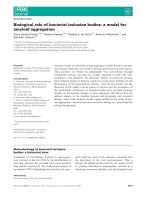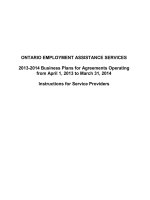COACHING FOR EMOTIONAL INTELLIGENCE potx
Bạn đang xem bản rút gọn của tài liệu. Xem và tải ngay bản đầy đủ của tài liệu tại đây (1.9 MB, 235 trang )
COACHING FOR
EMOTIONAL
INTELLIGENCE
PAGE i
16048$ $$FM 06-22-06 14:36:00 PS
PAGE ii
16048$ $$FM 06-22-06 14:36:01 PS
This page intentionally left blank
COACHING FOR
EMOTIONAL
INTELLIGENCE
The Secret to Developing the
Star Potential in Your Employees
Bob Wall
American Management Association
New York • Atlanta • Brussels • Chicago • Mexico City • San Francisco
Shanghai • Tokyo • Toronto • Washington, D.C.
PAGE iii
16048$ $$FM 06-22-06 14:36:01 PS
Special discounts on bulk quantities of AMACOM books are
available to corporations, professional associations, and other
organizations. For details, contact Special Sales Department,
AMACOM, a division of American Management Association,
1601 Broadway, New York, NY 10019.
Tel.: 212-903-8316. Fax: 212-903-8083.
Web site: www.amacombooks.org
This publication is designed to provide accurate and authoritative
information in regard to the subject matter covered. It is sold with the
understanding that the publisher is not engaged in rendering legal,
accounting, or other professional service. If legal advice or other expert
assistance is required, the services of a competent professional person
should be sought.
Library of Congress Cataloging-in-Publication Data
Wall, Bob (Bob Lee)
Coaching for emotional intelligence : the secret to developing the star potential in
your employees / Bob Wall.
p. cm.
Includes bibliographical references and index.
ISBN-10: 0-8144-0890-7
ISBN-13: 978-0-8144-0890-2
1. Employees—Coaching of. 2. Emotional intelligence—Study and teaching.
3. Performance—Psychological aspects. 4. Career development—Psychological
aspects. 5. Management—Psychological aspects. I. Title.
HF5549.5.C53W35 2007
658.3Ј124—dc22
2006010834
᭧ 2007 Bob Wall.
All rights reserved.
Printed in the United States of America.
This publication may not be reproduced,
stored in a retrieval system,
or transmitted in whole or in part,
in any form or by any means, electronic,
mechanical, photocopying, recording, or otherwise,
without the prior written permission of AMACOM,
a division of American Management Association,
1601 Broadway, New York, NY 10019.
Printing number
10987654321
PAGE iv
16048$ $$FM 06-22-06 14:36:02 PS
T
OMYWIFE
,A
DRIENNE
PAGE v
16048$ $$FM 06-22-06 14:36:02 PS
PAGE vi
16048$ $$FM 06-22-06 14:36:02 PS
This page intentionally left blank
CONTENTS
Acknowledgments xiii
Introduction 1
PA R T I
THE IMPACT OF EMOTIONAL
INTELLIGENCE ON
COACHING AND DEVELOPMENT 11
1 Understanding Emotional Intelligence 13
The Emergence of Emotional Intelligence:
Why Sheer Brainpower Just Isn’t Enough 14
Defining Emotional Intelligence 14
Lynn’s Model of Emotional Intelligence 15
Mastery of Mission, Vision, and Guiding Principles 16
Self-Awareness and Self-Control 19
Empathy 20
Social Expertness 25
Personal Influence 30
PAGE vii
vii
16048$ CNTS 06-22-06 14:36:04 PS
viii
CONTENTS
Skill Application 32
Reflections 41
2 The Role of Emotional Intelligence in
Professional Success 45
Emotional Intelligence and the Complexity of Work 45
Emotional Intelligence and High IQ Professions 47
Emotional Intelligence and Leadership 48
Matching Emotional Intelligence to the Position:
The Simmons EQ Profile 50
Reflections 58
3 How Emotional Intelligence Raises the Bar for Coaching 62
The Scarcity of Coaching in the Workplace 63
Why Managers Don’t Coach As Often As They
Should 65
The Impact of Emotional Intelligence and Coaching
Provided by Managers 67
Performance Management vs. Coaching for
Emotional Intelligence 67
Reflections 69
4 Coaching and the Diversity of the Human Experience 71
The Influence of Genetics 72
Growing Up in a Small Town 73
Formative Circumstances and Experiences 75
Everyone Has a Stor y 80
Reflections 80
PAGE viii
16048$ CNTS 06-22-06 14:36:04 PS
ix
CONTENTS
PA R T I I
COACHING FUNDAMENTALS 83
5 Personal Connections: Laying the Foundation
for Coaching 85
Work and Leadership in the Industrial Age 86
Sweeping Change: Leadership in the Information Age 87
Can Coaching Have an Impact on Emotional
Intelligence? 90
Five Requirements for Effective Coaching 91
Reflections 97
6 Improving Your Descriptive Skills 99
Good Coaching Makes Performance
Appraisals Easier 100
Describing Performance: Elemental Skills
for Coaching 101
Describing Performance in Need of Improvement 105
Describing Performance That Meets Your
Expectations 107
Skill Development 110
7 So Now What Do You Say? A Structured Format for
Coaching 111
Opening Statement 113
Observation 115
Impact 116
Request 117
Skill Development 118
PAGE ix
16048$ CNTS 06-22-06 14:36:04 PS
x
CONTENTS
PA R T I I I
FROM THEORY TO PRACTICE:
COACHING IN THE REAL WORLD 119
8 Praise: Such a Small Effort—Such a Huge Return 121
Delivering Praise 121
Why Don’t Managers Praise More? 126
Guidelines for Effective Praise 128
Structured Format for Praise 131
Praise to Acknowledge Performance 131
Praise to Acknowledge Emotional Intelligence 134
Reflections 136
Skill Applications 137
9 Corrective Coaching for Job Performance 139
Questions Often Asked About Corrective Coaching 139
Formulating Corrective Coaching 144
Examples of Corrective Coaching for Performance 145
Skill Development 148
Skill Applications 148
10 Corrective Coaching to Develop Emotional Intelligence 150
Core Beliefs 151
Behaviors That Require Coaching 152
Four Steps in Coaching for Emotional Intelligence 155
Spontaneous Coaching 156
Skill Development 161
Skill Applications 162
PAGE x
16048$ CNTS 06-22-06 14:36:05 PS
xi
CONTENTS
11 Preparing for a Formal Coaching Interview 163
Gathering and Recording Information 164
The Coaching Preparation Worksheet 164
Skill Application 168
12 Structuring the Formal Coaching Interview 174
The Formal Coaching Interview Form 174
Factors to Consider 177
Structuring the Interview 178
The Importance of Follow-Up 180
Case Study: Sample Formal Coaching Interview 180
Follow-Up Coaching 191
13 The Limitations of Coaching 194
Invest Your Coaching Time Wisely 195
Making the Call: When to Coach and When to
Cut Bait 196
A Failure of Nerve 199
Responding to Psychological and Physical Conditions 201
Making a Referral for an Evaluation 205
Reflections 207
Afterword 209
Recommended Readings 211
Index 215
About the Author 221
PAGE xi
16048$ CNTS 06-22-06 14:36:05 PS
PAGE xii
16048$ CNTS 06-22-06 14:36:05 PS
This page intentionally left blank
ACKNOWLEDGMENTS
I WANT TO EXPRESS MY GRATITUDE
to Jack and Steve Simmons,
developers of The Simmons Personal Profile and the EQ Profile. For
thirty years, Simmons Management Systems has been dedicated to
developing and perfecting an instrument that provides an uncannily
accurate assessment of characteristics we now put under the heading
of emotional intelligence. Their EQ Profile has proven to be invalu-
able in my work with clients in coaching for emotional intelligence.
I am especially appreciative to Steve, Jill, and Bonnie for their gra-
cious friendship and support.
To my friend and colleague, Wes Crane, my profound apprecia-
tion for his friendship and his mentorship in the interpretation of
the EQ Profile. His insights into emotional intelligence have been a
great influence in my development as a person and coach. His per-
sonal integrity and his generosity in sharing his time and knowledge
have been an inspiration to me.
My thanks to my friend, Jerry Brooker, for his personal support
and encouragement in helping me get into action and get this book
written. He kept reminding me that books are written one day at a
time and that my job was to make the best use of each of those days
to make progress on the book. Thanks, Jerry, for helping me eat the
elephant in small bites.
For the third time, my literary agent, John Willig of Literary
PAGE xiii
xiii
16048$ $ACK 06-22-06 14:36:08 PS
INTRODUCTION
IWANTTOINVITEYOU
to join me in a personal journey of self-
exploration and discovery. This is a book about coaching people to
develop their emotional intelligence. You cannot approach this topic
as a coach without taking a close look at yourself and the life experi-
ences, beliefs, attitudes, assumptions, and personal abilities that have
shaped the development of your own emotional intelligence.
There is an underlying assumption present in all coaching: that
the coach has developed deeper mastery of the knowledge and skills
of a topic than the person receiving the coaching. For most manag-
ers, this is no problem when dealing with the technical aspects of
the job. People get promoted and promoted again because they con-
tinue to demonstrate their insight into the knowledge, abilities, and
skills necessary to perform well in their chosen professions.
We must bring the same assumption to coaching for emotional
intelligence: that coaches have developed a higher level of mastery
of emotional intelligence than the people they are coaching. This
requires you to become a student of emotional intelligence and lead
the way by embodying the characteristics you want to develop in
others. This may strike you as an impossible standard to meet. In
truth, it is.
The mastery of emotional intelligence is a life-long journey. As
PAGE 1
1
16048$ INTR 06-22-06 14:36:16 PS
2
INTRODUCTION
you set out to learn more about how to coach for emotional intelli-
gence, it is important to bear three things in mind:
1. No one has perfect mastery of emotional intelligence. Each
of us brings to this topic our own unique blend of strengths and
characteristics that develop over a lifetime of experience.
2. As opposed to IQ that is fixed at birth, emotional intelli-
gence is fluid and constantly evolving. As we grow older, our emo-
tional intelligence continues to develop. Life experience shapes our
perceptions of ourselves, our personal discipline and character, and
how we deal with the interpersonal aspects of our lives.
3. This book contains Reflections, Skill Development, and Skill
Application exercises. These are assignments designed to accelerate
the growth and expression of your own emotional intelligence and
your effectiveness as a coach. While the book is focused on coaching
others, you cannot approach this topic without expanding your own
self-awareness and developing greater mastery of those aspects of
your emotional intelligence that present opportunities for growth.
Approach this book in the spirit of self-discovery. I’ve structured
the writing much as I would structure conversations we would have
if I were serving as your personal executive coach. Where appro-
priate, I will share some of the personal lessons that have been in-
strumental in my own development, not that I claim to be fully
evolved emotionally. I don’t know anyone who is. But the more we
study this topic and apply what we learn to our own lives, the better
we become at coaching others to develop their emotional intelli-
gence.
AN OVERVIEW OF EXERCISES
INCLUDED IN THIS BOOK
If all you do is read this book, you might pick up some interesting
information, but in the end, the time invested in your reading will
PAGE 2
16048$ INTR 06-22-06 14:36:16 PS
3
INTRODUCTION
make little or no difference in the quality of your coaching. This is
not just another management book for you to read and put on the
shelf. To gain the maximum benefit from the book, I am asking you
to make a commitment to engage with this book in the same spirit
you would if you had acquired an executive coach to develop your
self-awareness and abilities as a leader. Executive coaches give peo-
ple a variety of assignments to do in the course of their work with
clients. In this book, I do much the same.
From time to time, I’ll pose questions for you to consider, exer-
cises to do, and skills to practice and incorporate into your leader-
ship. All the ‘‘assignments’’ you’ll find in the book are based on
conversations and skill development sessions I’ve had working as an
executive coach with my clients.
Executive coaching only works to the extent my clients invest
themselves and their time in learning from the process. I’m counting
on you to take time to reflect on the questions posed and do the
exercises necessary to assist you in becoming a more effective coach.
I know you are a busy person but the only way this book will make
a difference for you is to make time available to follow directions
where you find them.
This is not a race. Take time to do the exercises and the quality
of your coaching will improve dramatically. You’ll become more ef-
fective in offering praise. You’ll become more at ease with corrective
coaching when performance does not meet your standards. And the
people you coach will show marked improvements in their perform-
ance. Pause right now and think about the people who repor t to
you. What improvements in their performance would make it worth
investing three to five hours in doing the assignments in this book?
I have worked very hard to make this an easy book to read:
short, to the point, and including only the most essential information
and theory. In most chapters, you will find assignments. These exer-
cises have been carefully designed and sequenced to help you trans-
late the concepts in the book into leadership skills you can put to
use in your work. Three different kinds of assignments are presented:
PAGE 3
16048$ INTR 06-22-06 14:36:17 PS
4
INTRODUCTION
1. Reflections
Coaching must produce changes in self-perception, knowledge,
attitudes, and skills. In ‘‘Reflections,’’ you will find questions or top-
ics to consider. Learning new skills and actually using them on the
job requires shifts in values, attitudes, and beliefs that will make you
more willing to put new skills to work on the job. The Reflections
have a very important purpose: for you to think about what you have
been reading and translate it into your own experience.
A recommendation: You will gain so much more from this book
if you invest time addressing each of the Reflections in writing. If
you write, you will engage with the topics and questions more fully
and state your opinions and feelings more clearly.
Like most leaders, you already have more than enough to do and
you may not want to take the time to write about the Reflections. If
I can’t convince you to do the work in writing, at least take time to
pause and reflect for a few moments on each of the questions and
topics you’ll find in the Reflections. Devoting a few minutes to each
one is an important step in fully benefiting from this book.
2. Skill Development
Skill development requires mastering elements that, when put
together properly, results in the development of a new skill. The
coaching skills presented in this book have been under development
from the time I first started leading workshops in the 1970s. These
methods have been continuously refined to produce the greatest pos-
sible results with the least amount of effort required on your part.
They are based on common sense and can be practiced, mastered,
and easily put to use in the real world. The more time you devote to
the exercises, the faster you’ll feel comfortable putting these skills to
use at work.
3. Skill Applications
This is the whole point of reading the book and doing the exer-
cises: putting the skills to use at work and, with practice, developing
skill mastery. As in learning any new skill, you might be awkward
PAGE 4
16048$ INTR 06-22-06 14:36:17 PS
5
INTRODUCTION
and self-conscious when trying these skills out for the first time.
You’ll have to think about each element of the skill and carefully put
them to use as I’ve described them. You’ll know you are developing
skill mastery when using the skill requires less and less conscious
attention and preparation.
The Reflections, Skill Development, and Skill Applications exer-
cises can be used in the coaching you are doing with the people who
report to you. The Reflections will lead to conversations that will
help you better understand your employees and how to support their
growth. If you are coaching people in leadership positions, they need
to develop their coaching skills as well as their emotional intelli-
gence. Before a coaching session, you will find it helpful to return to
the book and review the Reflections, Skill Development, and Skill
Applications exercises for ideas to bring to your coaching conversa-
tions.
A Word About Terminology
The coaching strategies in this book are appropriate for use by all
levels of management. The subjects of coaching would differ for vari-
ous levels of management but the principles of coaching apply just
as well for a CEO as they do for a first-line supervisor. For simplicity
of writing, I’ve chosen to use the terms ‘‘manager’’ and ‘‘leader’’ to
refer to those proving the coaching, and the terms ‘‘associates,’’ ‘‘em-
ployees,’’ and ‘‘direct reports’’ in referring to those on the receiving
end of the coaching.
PUTTING OUR CONVERSATION IN CONTEXT
You wouldn’t hire executive coaches for your company without care-
fully looking into the background, training, experience, and qualities
PAGE 5
16048$ INTR 06-22-06 14:36:17 PS
6
INTRODUCTION
they bring to their work. Conversations with other executive coaches
and organizational development specialists have revealed that we
have discovered our passion for this kind of work by following very
different pathways over the course of our careers. So I want to tell
you just enough about myself to help you understand how I found
my way into a career I love and the kinds of projects I do. Knowing
my history will help you understand how I arrived at the coaching
strategies you’ll find in this book.
As I write these words, I’ve been an independent management
consultant for 26 years. The purpose of my work is to accelerate
leadership, team, and cultural development, creating more successful
organizations while enhancing the quality of life for the people who
work in them.
I am a clinical psychologist by training. As a graduate student
working on a Ph.D., I participated in a federally funded project to
provide interpersonal skills workshops for human service organiza-
tions. Little did I know that in joining this project, I was to find my
life’s calling. I discovered a passion for workshop design and group
facilitation. Most of all, I came to love the challenge of studying
complex human interactions and developing simple models and
communication strategies to help people deal with these interactions
more effectively.
I started experimenting with management training at a hospital
where I was employed part time as a graduate student, and I found
myself drawn to books on leadership and organizational develop-
ment. I had completed all my course work and clinical training and
had passed the comprehensive examination, qualifying me as a
Ph.D. candidate, when the grant supporting our training project ex-
pired.
A small group of us from the project got together to discuss
making a dramatic change in direction. We loved designing and lead-
ing workshops, so why not leave graduate school and move to the
city of our choice to start a consulting and training business? We
moved to Seattle in 1980, without a clue that trying to start a con-
PAGE 6
16048$ INTR 06-22-06 14:36:17 PS
7
INTRODUCTION
sulting business in a city where you don’t know a soul was not a very
good idea. But fortunately we didn’t know what we didn’t know.
For the first two or three years, if I was awake, I was working—
designing and redesigning workshops, writing lectures, and designing
strategies and skills to help people deal more effectively with the
communication challenges they face at work. It was a period of tre-
mendous creativity, hard work, and learning from clients about the
challenges they faced at work every day.
Working with managers, we learned about the challenges of
coaching and dealing with people who seemed to be committed to
dancing to the beat of a different drummer. In stress management
and conflict management workshops, we spent hours in discussions
with hundreds of people learning about the problems people faced
in their jobs and the difficulties they faced in their relationships with
their managers and peers.
While I still do engagements as a stand-up trainer, my work is
now almost completely devoted to organizational assessment, execu-
tive coaching, and helping leaders and teams get to where they want
to go faster than they would get there on their own. I get involved in
a wide variety of projects, including:
• I work with leaders who have recently taken the helm of a
company or a division within a company. After they’ve cleaned
house and developed a new direction, I assist them in rebuilding the
trust, communications, culture, leadership, and teamwork necessary
to get the organization moving as quickly as possible.
• I evaluate and coach leaders who are technically gifted but
whose management styles are creating high turnover and low mo-
rale. The work involves determining whether these leaders can be
saved and what it is going to take to make it happen.
• I help companies cope with growth, reorganization, and
other forms of change.
• I work with individuals and teams whose relationships are
fractured, affecting both productivity and morale.
PAGE 7
16048$ INTR 06-22-06 14:36:18 PS
8
INTRODUCTION
• I work with organizations dealing with mergers and acquisi-
tions, helping them recreate their cultural values and accelerate the
development of newly forming teams.
The Organizational Snapshot
At the start of every consulting project, I do a series of private, confi-
dential interviews with executives and managers as well as with a
representative sampling of associates. The purpose of these inter-
views is to discover what life inside the company looks like from
each person’s point of view. What do they love about their jobs?
What changes would they like to see made? What is working well?
What isn’t? What is going on beneath the surface? What problems
are obvious to everyone but are not being addressed?
At the appropriate point in the inter view, I ask about a list of
executives and managers by name. I explain that, if I want to under-
stand the culture and effectiveness of the organization, I need to
know how people in management positions are doing. What do these
people do well and what could they do differently that would make
them more effective? Given the promise of complete anonymity,
people are dying to talk about the source of most of their frustrations
at work: management. I’ve learned about what managers do that
drives people crazy, limiting the effectiveness of their teams and
damaging morale. And I’ve also learned about great leaders and
what makes them so inspiring at the organizational and personal
level.
APPLYING LESSONS LEARNED
FROM MY CLIENTS
This book is based on the lessons I’ve learned in discussions about
work with thousands of people in all walks of life and every level of
their organizations. I’ve been privileged to work with people who
PAGE 8
16048$ INTR 06-22-06 14:36:18 PS
9
INTRODUCTION
trusted me enough to share their experiences with me in training
rooms, corporate retreats, organizational development projects, and
individual coaching sessions. They have allowed me to look into
their lives and learn about life in their organizations and about work
and the meaning it has in their lives. And I have also learned how
important the relationships between leaders and their teams are in
determining both the effectiveness of the teams and the satisfaction
people find in doing their work.
Everything you find in this book is distilled from what I have
learned from people much like you, discussing what leaders and
their teams want and need from each other, and developing simple
principles and communication strategies to help people create lives
at work that are both productive and the source of deep satisfaction
and meaning.
The coaching skills in these pages have been tested and refined
based on feedback from my clients. If you incorporate these skills
into your leadership activities, I promise that you will become more
effective and more personally comfortable with the whole activity of
coaching.
My approach to coaching is based on common sense: techniques
that are easy to learn, remember, and apply in the pressured environ-
ment of work. You’ll find that you already know much of what you
will read in this book. We’ll reorganize what you know and provide
communication strategies that will lead to improved performance by
your direct reports.
But simple does not necessarily mean easy. Any change in
human behavior takes work and results in discomfort for a time.
You’ll be trying on new behaviors and may feel awkward and uncom-
fortable at first. But with practice, these skills will feel more natural
and, in time, they will become integrated into your leadership style.
Coaching Doesn’t Have to Be Hard
It strikes me that the topic of performance management has become
overly complicated. Leaders get so caught up in creating perform-
PAGE 9
16048$ INTR 06-22-06 14:36:18 PS
10
INTRODUCTION
ance agreements and complying with organizational requirements
for performance management that the whole point of coaching has
been lost. Coaching, as defined in this book, is nothing more com-
plex than having conversations with employees about their perform-
ance. If conversations about performance are infrequent or
nonexistent, no formal organizational rituals or paperwork can possi-
bly result in anything that approximates responsible employee and
leadership development.
Now let’s get to work.
PAGE 10
16048$ INTR 06-22-06 14:36:18 PS
PART 1
THE IMPACT OF
EMOTIONAL INTELLIGENCE
ON COACHING AND
DEVELOPMENT
PAGE 11
16048$ PRT1 06-22-06 14:36:21 PS









